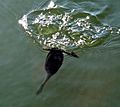Surface wave facts for kids
In physics, a surface wave can refer to a mechanical wave that propagates along the interface between differing media, usually two fluids with different densities. A surface wave can also be an electromagnetic wave guided by a refractive index gradient. For radio waves, a ground wave is a surface wave that propagates close to the surface of the Earth.
Contents
Related pages
Waves
- Ocean surface waves, internal waves and crests, dispersion, and freak waves
- List of wave topics
People
- Arnold Sommerfeld – published the mathematical treatise on the zenneck wave
Images for kids
-
The E-field of a surface plasmon polariton at an silver-air interface, at a low frequency corresponding to a free-space wavelength of 10μm. At this frequency, the silver behaves approximately as a perfect electric conductor, and the SPP is called a Sommerfeld-Zenneck wave, with almost the same wavelength as the free-space wavelength.
-
Diving grebe creates surface waves

All content from Kiddle encyclopedia articles (including the article images and facts) can be freely used under Attribution-ShareAlike license, unless stated otherwise. Cite this article:
Surface wave Facts for Kids. Kiddle Encyclopedia.



